Nursing Case Study Report Analysis
VerifiedAdded on 2022/08/17
|11
|3287
|17
AI Summary
Contribute Materials
Your contribution can guide someone’s learning journey. Share your
documents today.
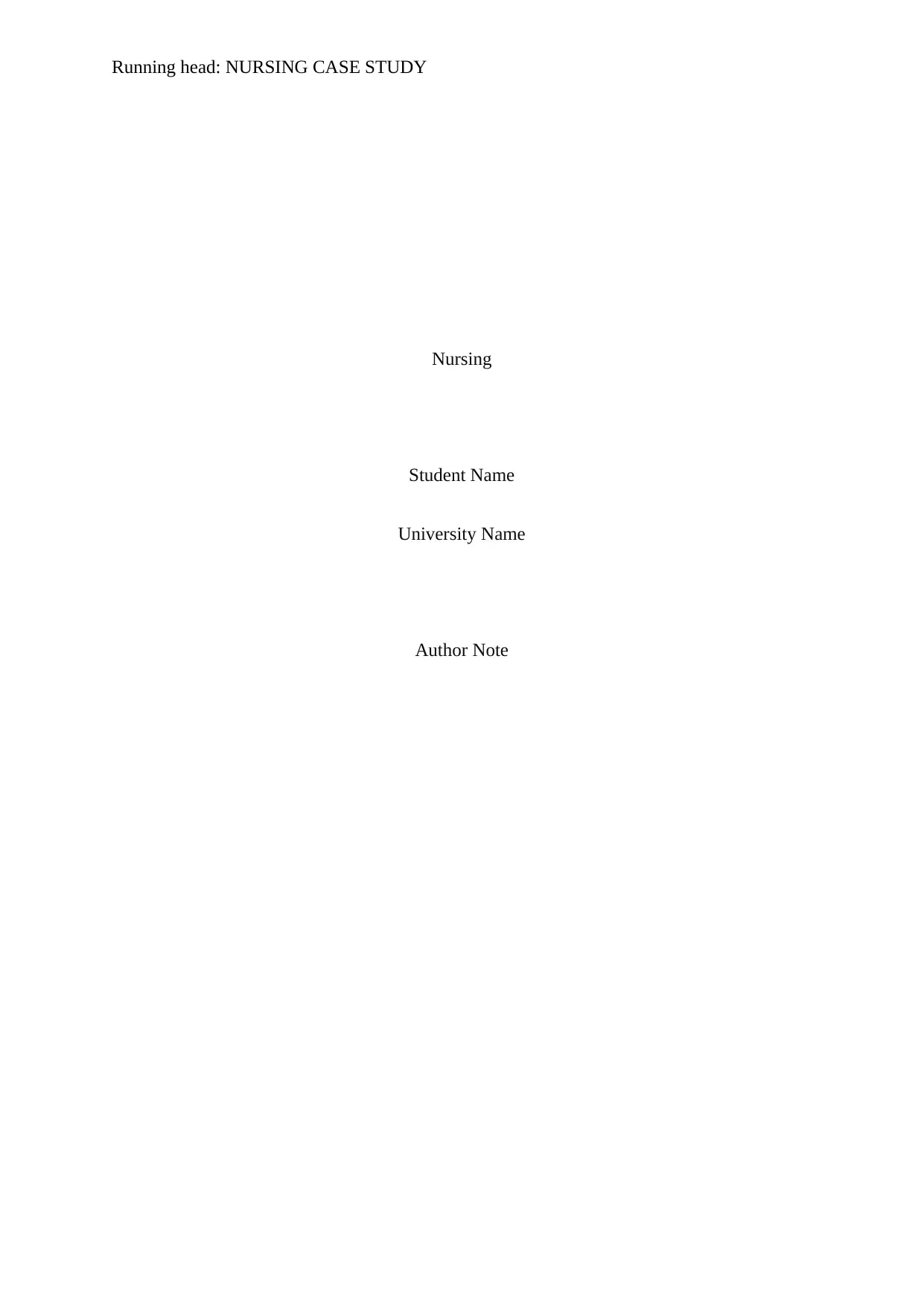
Running head: NURSING CASE STUDY
Nursing
Student Name
University Name
Author Note
Nursing
Student Name
University Name
Author Note
Secure Best Marks with AI Grader
Need help grading? Try our AI Grader for instant feedback on your assignments.
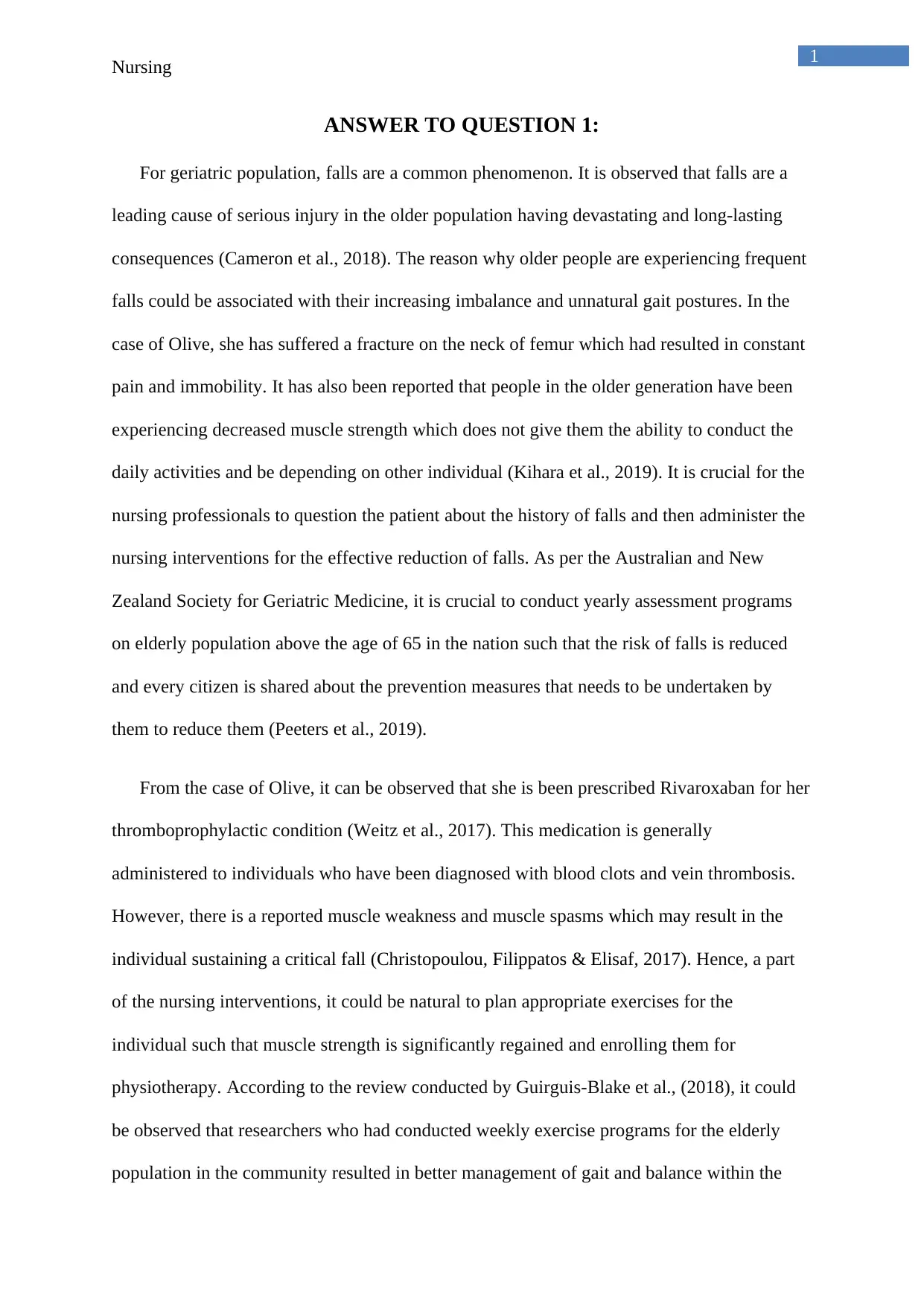
1
Nursing
ANSWER TO QUESTION 1:
For geriatric population, falls are a common phenomenon. It is observed that falls are a
leading cause of serious injury in the older population having devastating and long-lasting
consequences (Cameron et al., 2018). The reason why older people are experiencing frequent
falls could be associated with their increasing imbalance and unnatural gait postures. In the
case of Olive, she has suffered a fracture on the neck of femur which had resulted in constant
pain and immobility. It has also been reported that people in the older generation have been
experiencing decreased muscle strength which does not give them the ability to conduct the
daily activities and be depending on other individual (Kihara et al., 2019). It is crucial for the
nursing professionals to question the patient about the history of falls and then administer the
nursing interventions for the effective reduction of falls. As per the Australian and New
Zealand Society for Geriatric Medicine, it is crucial to conduct yearly assessment programs
on elderly population above the age of 65 in the nation such that the risk of falls is reduced
and every citizen is shared about the prevention measures that needs to be undertaken by
them to reduce them (Peeters et al., 2019).
From the case of Olive, it can be observed that she is been prescribed Rivaroxaban for her
thromboprophylactic condition (Weitz et al., 2017). This medication is generally
administered to individuals who have been diagnosed with blood clots and vein thrombosis.
However, there is a reported muscle weakness and muscle spasms which may result in the
individual sustaining a critical fall (Christopoulou, Filippatos & Elisaf, 2017). Hence, a part
of the nursing interventions, it could be natural to plan appropriate exercises for the
individual such that muscle strength is significantly regained and enrolling them for
physiotherapy. According to the review conducted by Guirguis-Blake et al., (2018), it could
be observed that researchers who had conducted weekly exercise programs for the elderly
population in the community resulted in better management of gait and balance within the
Nursing
ANSWER TO QUESTION 1:
For geriatric population, falls are a common phenomenon. It is observed that falls are a
leading cause of serious injury in the older population having devastating and long-lasting
consequences (Cameron et al., 2018). The reason why older people are experiencing frequent
falls could be associated with their increasing imbalance and unnatural gait postures. In the
case of Olive, she has suffered a fracture on the neck of femur which had resulted in constant
pain and immobility. It has also been reported that people in the older generation have been
experiencing decreased muscle strength which does not give them the ability to conduct the
daily activities and be depending on other individual (Kihara et al., 2019). It is crucial for the
nursing professionals to question the patient about the history of falls and then administer the
nursing interventions for the effective reduction of falls. As per the Australian and New
Zealand Society for Geriatric Medicine, it is crucial to conduct yearly assessment programs
on elderly population above the age of 65 in the nation such that the risk of falls is reduced
and every citizen is shared about the prevention measures that needs to be undertaken by
them to reduce them (Peeters et al., 2019).
From the case of Olive, it can be observed that she is been prescribed Rivaroxaban for her
thromboprophylactic condition (Weitz et al., 2017). This medication is generally
administered to individuals who have been diagnosed with blood clots and vein thrombosis.
However, there is a reported muscle weakness and muscle spasms which may result in the
individual sustaining a critical fall (Christopoulou, Filippatos & Elisaf, 2017). Hence, a part
of the nursing interventions, it could be natural to plan appropriate exercises for the
individual such that muscle strength is significantly regained and enrolling them for
physiotherapy. According to the review conducted by Guirguis-Blake et al., (2018), it could
be observed that researchers who had conducted weekly exercise programs for the elderly
population in the community resulted in better management of gait and balance within the
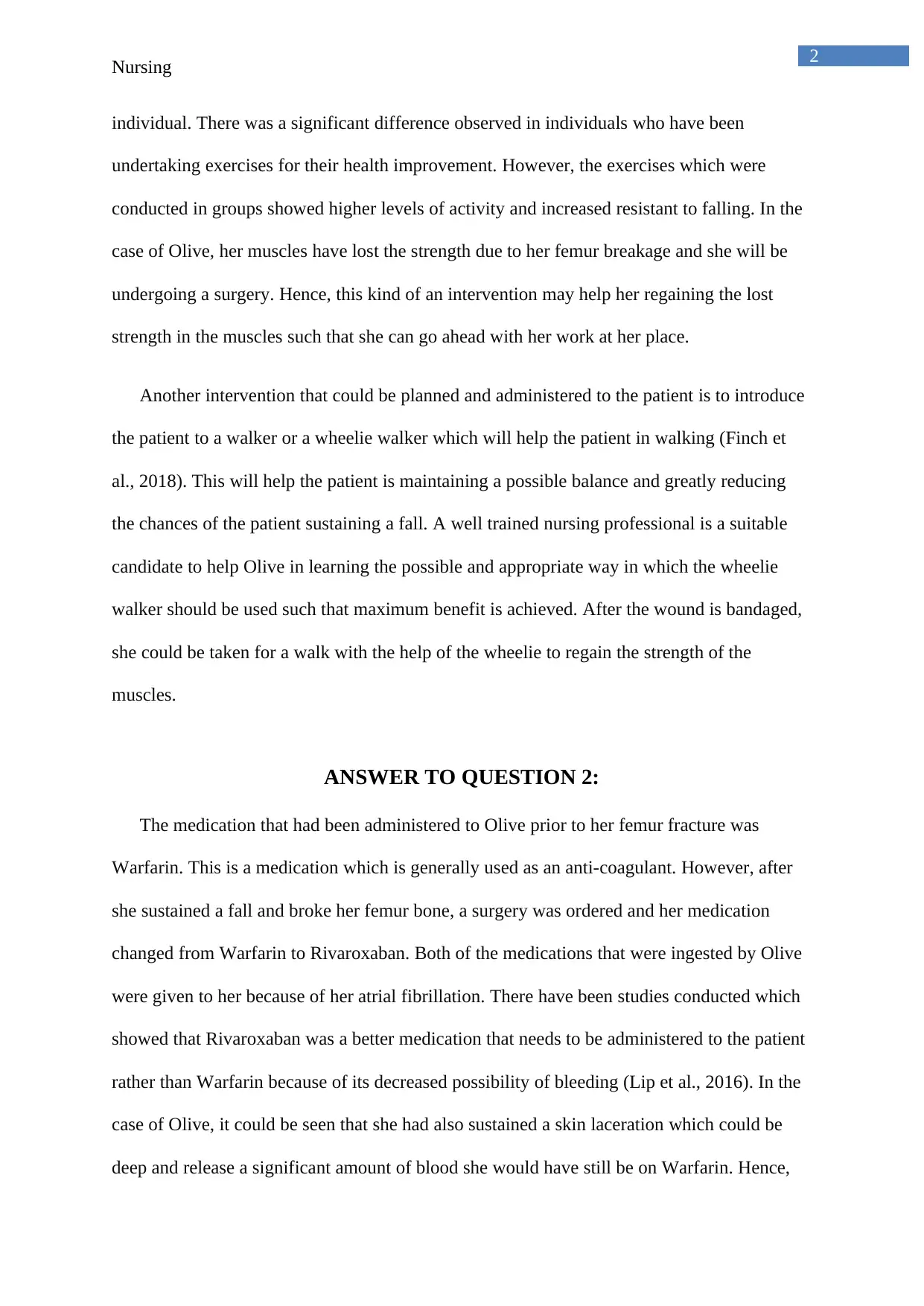
2
Nursing
individual. There was a significant difference observed in individuals who have been
undertaking exercises for their health improvement. However, the exercises which were
conducted in groups showed higher levels of activity and increased resistant to falling. In the
case of Olive, her muscles have lost the strength due to her femur breakage and she will be
undergoing a surgery. Hence, this kind of an intervention may help her regaining the lost
strength in the muscles such that she can go ahead with her work at her place.
Another intervention that could be planned and administered to the patient is to introduce
the patient to a walker or a wheelie walker which will help the patient in walking (Finch et
al., 2018). This will help the patient is maintaining a possible balance and greatly reducing
the chances of the patient sustaining a fall. A well trained nursing professional is a suitable
candidate to help Olive in learning the possible and appropriate way in which the wheelie
walker should be used such that maximum benefit is achieved. After the wound is bandaged,
she could be taken for a walk with the help of the wheelie to regain the strength of the
muscles.
ANSWER TO QUESTION 2:
The medication that had been administered to Olive prior to her femur fracture was
Warfarin. This is a medication which is generally used as an anti-coagulant. However, after
she sustained a fall and broke her femur bone, a surgery was ordered and her medication
changed from Warfarin to Rivaroxaban. Both of the medications that were ingested by Olive
were given to her because of her atrial fibrillation. There have been studies conducted which
showed that Rivaroxaban was a better medication that needs to be administered to the patient
rather than Warfarin because of its decreased possibility of bleeding (Lip et al., 2016). In the
case of Olive, it could be seen that she had also sustained a skin laceration which could be
deep and release a significant amount of blood she would have still be on Warfarin. Hence,
Nursing
individual. There was a significant difference observed in individuals who have been
undertaking exercises for their health improvement. However, the exercises which were
conducted in groups showed higher levels of activity and increased resistant to falling. In the
case of Olive, her muscles have lost the strength due to her femur breakage and she will be
undergoing a surgery. Hence, this kind of an intervention may help her regaining the lost
strength in the muscles such that she can go ahead with her work at her place.
Another intervention that could be planned and administered to the patient is to introduce
the patient to a walker or a wheelie walker which will help the patient in walking (Finch et
al., 2018). This will help the patient is maintaining a possible balance and greatly reducing
the chances of the patient sustaining a fall. A well trained nursing professional is a suitable
candidate to help Olive in learning the possible and appropriate way in which the wheelie
walker should be used such that maximum benefit is achieved. After the wound is bandaged,
she could be taken for a walk with the help of the wheelie to regain the strength of the
muscles.
ANSWER TO QUESTION 2:
The medication that had been administered to Olive prior to her femur fracture was
Warfarin. This is a medication which is generally used as an anti-coagulant. However, after
she sustained a fall and broke her femur bone, a surgery was ordered and her medication
changed from Warfarin to Rivaroxaban. Both of the medications that were ingested by Olive
were given to her because of her atrial fibrillation. There have been studies conducted which
showed that Rivaroxaban was a better medication that needs to be administered to the patient
rather than Warfarin because of its decreased possibility of bleeding (Lip et al., 2016). In the
case of Olive, it could be seen that she had also sustained a skin laceration which could be
deep and release a significant amount of blood she would have still be on Warfarin. Hence,
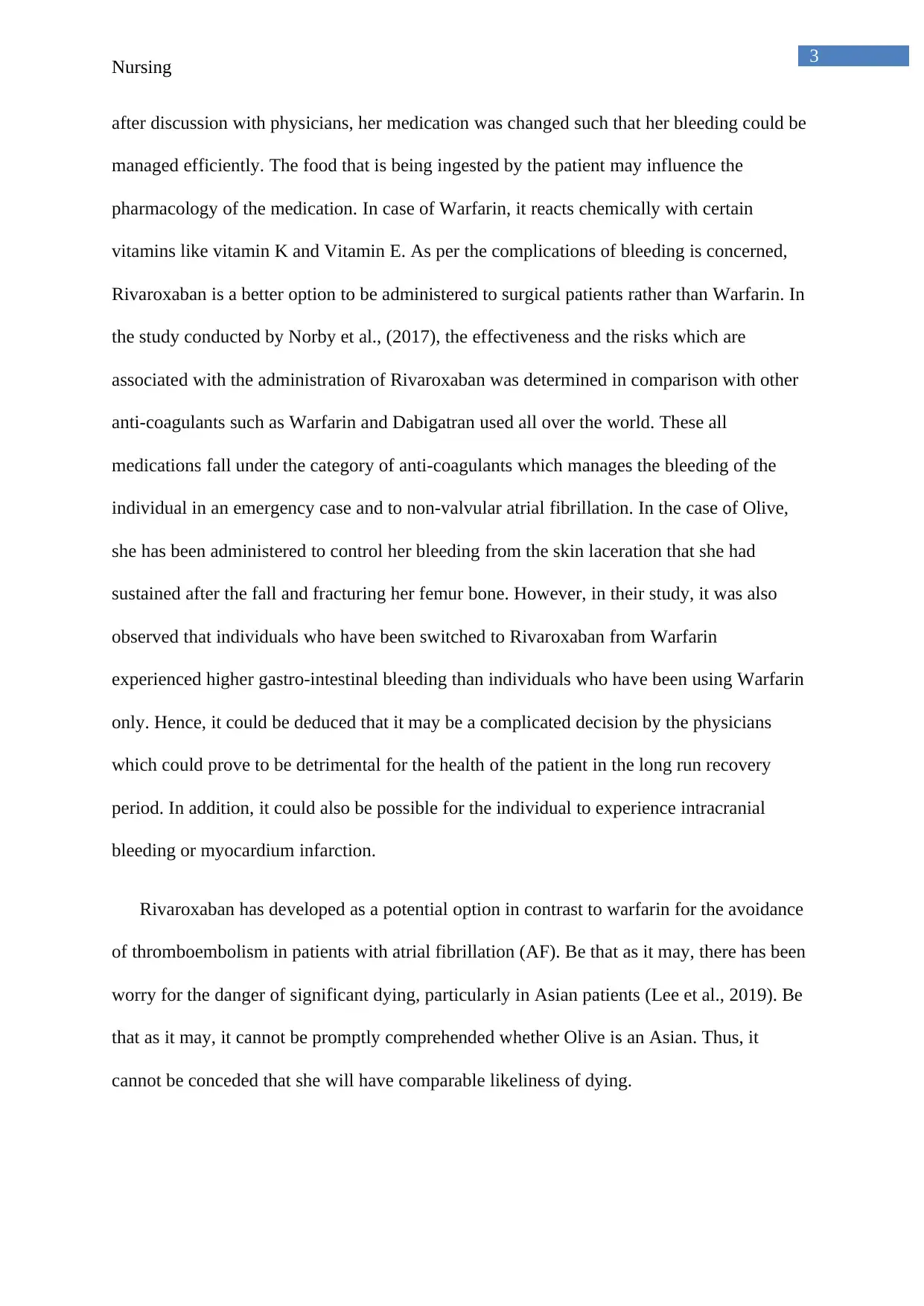
3
Nursing
after discussion with physicians, her medication was changed such that her bleeding could be
managed efficiently. The food that is being ingested by the patient may influence the
pharmacology of the medication. In case of Warfarin, it reacts chemically with certain
vitamins like vitamin K and Vitamin E. As per the complications of bleeding is concerned,
Rivaroxaban is a better option to be administered to surgical patients rather than Warfarin. In
the study conducted by Norby et al., (2017), the effectiveness and the risks which are
associated with the administration of Rivaroxaban was determined in comparison with other
anti-coagulants such as Warfarin and Dabigatran used all over the world. These all
medications fall under the category of anti-coagulants which manages the bleeding of the
individual in an emergency case and to non-valvular atrial fibrillation. In the case of Olive,
she has been administered to control her bleeding from the skin laceration that she had
sustained after the fall and fracturing her femur bone. However, in their study, it was also
observed that individuals who have been switched to Rivaroxaban from Warfarin
experienced higher gastro-intestinal bleeding than individuals who have been using Warfarin
only. Hence, it could be deduced that it may be a complicated decision by the physicians
which could prove to be detrimental for the health of the patient in the long run recovery
period. In addition, it could also be possible for the individual to experience intracranial
bleeding or myocardium infarction.
Rivaroxaban has developed as a potential option in contrast to warfarin for the avoidance
of thromboembolism in patients with atrial fibrillation (AF). Be that as it may, there has been
worry for the danger of significant dying, particularly in Asian patients (Lee et al., 2019). Be
that as it may, it cannot be promptly comprehended whether Olive is an Asian. Thus, it
cannot be conceded that she will have comparable likeliness of dying.
Nursing
after discussion with physicians, her medication was changed such that her bleeding could be
managed efficiently. The food that is being ingested by the patient may influence the
pharmacology of the medication. In case of Warfarin, it reacts chemically with certain
vitamins like vitamin K and Vitamin E. As per the complications of bleeding is concerned,
Rivaroxaban is a better option to be administered to surgical patients rather than Warfarin. In
the study conducted by Norby et al., (2017), the effectiveness and the risks which are
associated with the administration of Rivaroxaban was determined in comparison with other
anti-coagulants such as Warfarin and Dabigatran used all over the world. These all
medications fall under the category of anti-coagulants which manages the bleeding of the
individual in an emergency case and to non-valvular atrial fibrillation. In the case of Olive,
she has been administered to control her bleeding from the skin laceration that she had
sustained after the fall and fracturing her femur bone. However, in their study, it was also
observed that individuals who have been switched to Rivaroxaban from Warfarin
experienced higher gastro-intestinal bleeding than individuals who have been using Warfarin
only. Hence, it could be deduced that it may be a complicated decision by the physicians
which could prove to be detrimental for the health of the patient in the long run recovery
period. In addition, it could also be possible for the individual to experience intracranial
bleeding or myocardium infarction.
Rivaroxaban has developed as a potential option in contrast to warfarin for the avoidance
of thromboembolism in patients with atrial fibrillation (AF). Be that as it may, there has been
worry for the danger of significant dying, particularly in Asian patients (Lee et al., 2019). Be
that as it may, it cannot be promptly comprehended whether Olive is an Asian. Thus, it
cannot be conceded that she will have comparable likeliness of dying.
Secure Best Marks with AI Grader
Need help grading? Try our AI Grader for instant feedback on your assignments.
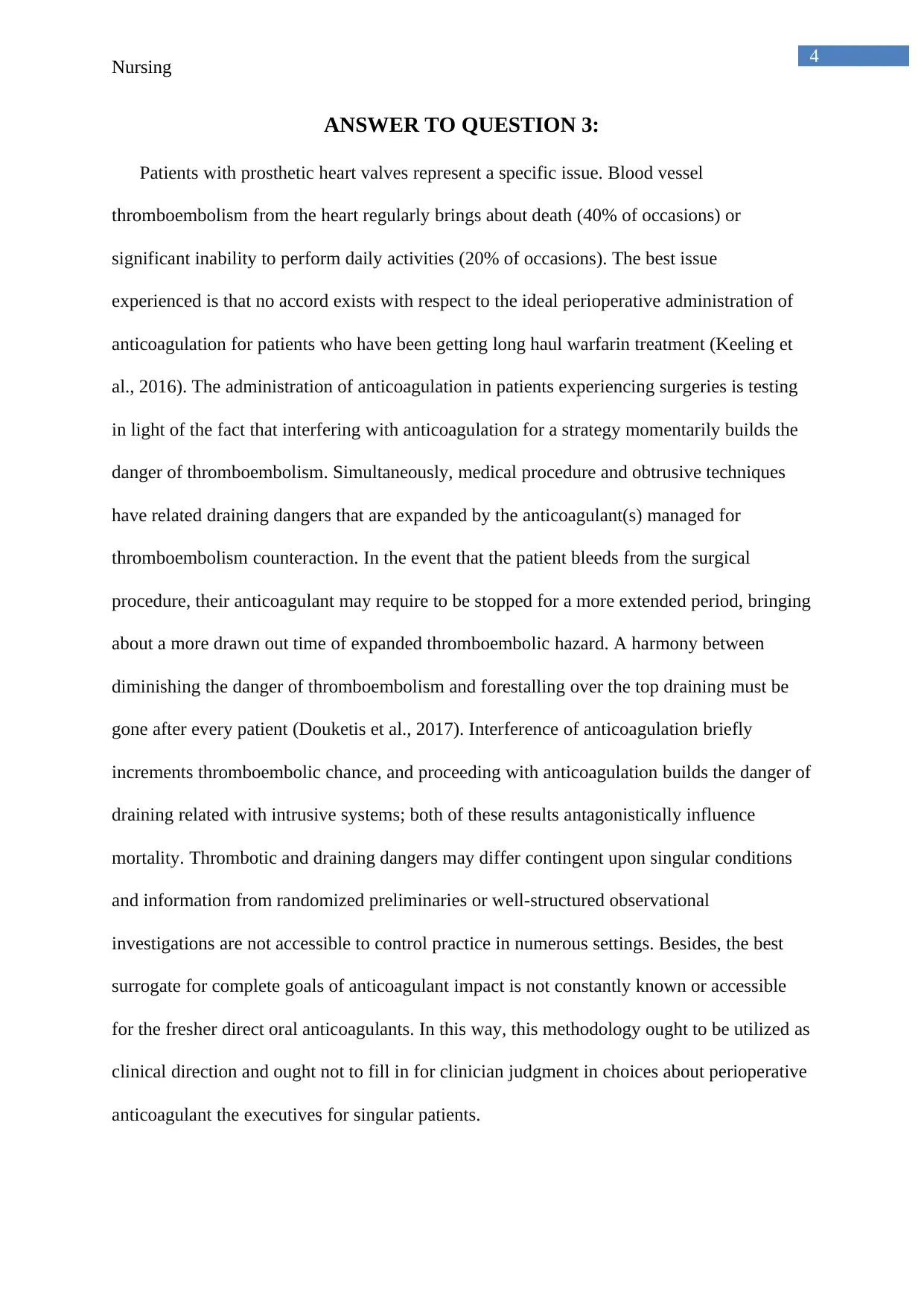
4
Nursing
ANSWER TO QUESTION 3:
Patients with prosthetic heart valves represent a specific issue. Blood vessel
thromboembolism from the heart regularly brings about death (40% of occasions) or
significant inability to perform daily activities (20% of occasions). The best issue
experienced is that no accord exists with respect to the ideal perioperative administration of
anticoagulation for patients who have been getting long haul warfarin treatment (Keeling et
al., 2016). The administration of anticoagulation in patients experiencing surgeries is testing
in light of the fact that interfering with anticoagulation for a strategy momentarily builds the
danger of thromboembolism. Simultaneously, medical procedure and obtrusive techniques
have related draining dangers that are expanded by the anticoagulant(s) managed for
thromboembolism counteraction. In the event that the patient bleeds from the surgical
procedure, their anticoagulant may require to be stopped for a more extended period, bringing
about a more drawn out time of expanded thromboembolic hazard. A harmony between
diminishing the danger of thromboembolism and forestalling over the top draining must be
gone after every patient (Douketis et al., 2017). Interference of anticoagulation briefly
increments thromboembolic chance, and proceeding with anticoagulation builds the danger of
draining related with intrusive systems; both of these results antagonistically influence
mortality. Thrombotic and draining dangers may differ contingent upon singular conditions
and information from randomized preliminaries or well-structured observational
investigations are not accessible to control practice in numerous settings. Besides, the best
surrogate for complete goals of anticoagulant impact is not constantly known or accessible
for the fresher direct oral anticoagulants. In this way, this methodology ought to be utilized as
clinical direction and ought not to fill in for clinician judgment in choices about perioperative
anticoagulant the executives for singular patients.
Nursing
ANSWER TO QUESTION 3:
Patients with prosthetic heart valves represent a specific issue. Blood vessel
thromboembolism from the heart regularly brings about death (40% of occasions) or
significant inability to perform daily activities (20% of occasions). The best issue
experienced is that no accord exists with respect to the ideal perioperative administration of
anticoagulation for patients who have been getting long haul warfarin treatment (Keeling et
al., 2016). The administration of anticoagulation in patients experiencing surgeries is testing
in light of the fact that interfering with anticoagulation for a strategy momentarily builds the
danger of thromboembolism. Simultaneously, medical procedure and obtrusive techniques
have related draining dangers that are expanded by the anticoagulant(s) managed for
thromboembolism counteraction. In the event that the patient bleeds from the surgical
procedure, their anticoagulant may require to be stopped for a more extended period, bringing
about a more drawn out time of expanded thromboembolic hazard. A harmony between
diminishing the danger of thromboembolism and forestalling over the top draining must be
gone after every patient (Douketis et al., 2017). Interference of anticoagulation briefly
increments thromboembolic chance, and proceeding with anticoagulation builds the danger of
draining related with intrusive systems; both of these results antagonistically influence
mortality. Thrombotic and draining dangers may differ contingent upon singular conditions
and information from randomized preliminaries or well-structured observational
investigations are not accessible to control practice in numerous settings. Besides, the best
surrogate for complete goals of anticoagulant impact is not constantly known or accessible
for the fresher direct oral anticoagulants. In this way, this methodology ought to be utilized as
clinical direction and ought not to fill in for clinician judgment in choices about perioperative
anticoagulant the executives for singular patients.
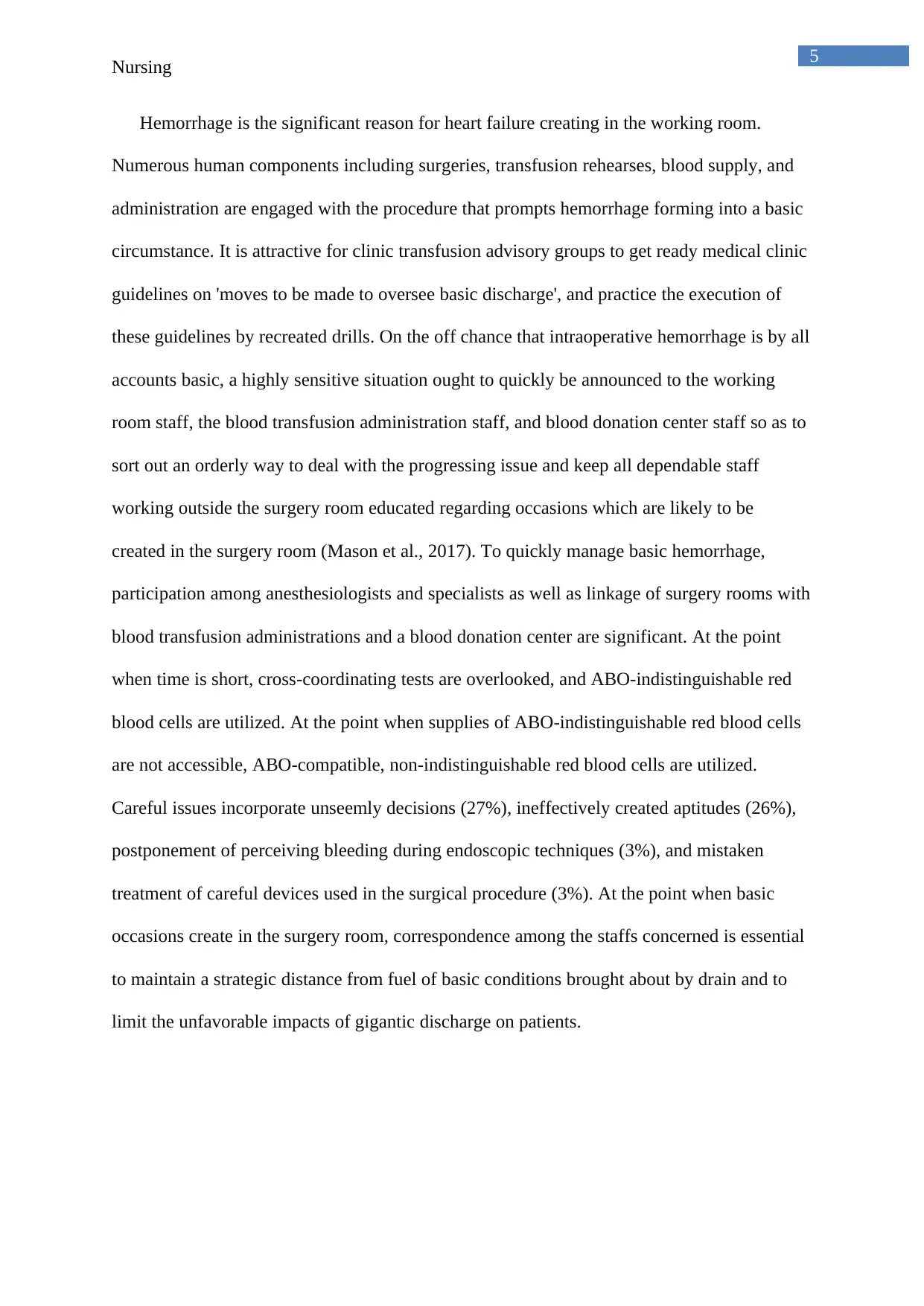
5
Nursing
Hemorrhage is the significant reason for heart failure creating in the working room.
Numerous human components including surgeries, transfusion rehearses, blood supply, and
administration are engaged with the procedure that prompts hemorrhage forming into a basic
circumstance. It is attractive for clinic transfusion advisory groups to get ready medical clinic
guidelines on 'moves to be made to oversee basic discharge', and practice the execution of
these guidelines by recreated drills. On the off chance that intraoperative hemorrhage is by all
accounts basic, a highly sensitive situation ought to quickly be announced to the working
room staff, the blood transfusion administration staff, and blood donation center staff so as to
sort out an orderly way to deal with the progressing issue and keep all dependable staff
working outside the surgery room educated regarding occasions which are likely to be
created in the surgery room (Mason et al., 2017). To quickly manage basic hemorrhage,
participation among anesthesiologists and specialists as well as linkage of surgery rooms with
blood transfusion administrations and a blood donation center are significant. At the point
when time is short, cross-coordinating tests are overlooked, and ABO-indistinguishable red
blood cells are utilized. At the point when supplies of ABO-indistinguishable red blood cells
are not accessible, ABO-compatible, non-indistinguishable red blood cells are utilized.
Careful issues incorporate unseemly decisions (27%), ineffectively created aptitudes (26%),
postponement of perceiving bleeding during endoscopic techniques (3%), and mistaken
treatment of careful devices used in the surgical procedure (3%). At the point when basic
occasions create in the surgery room, correspondence among the staffs concerned is essential
to maintain a strategic distance from fuel of basic conditions brought about by drain and to
limit the unfavorable impacts of gigantic discharge on patients.
Nursing
Hemorrhage is the significant reason for heart failure creating in the working room.
Numerous human components including surgeries, transfusion rehearses, blood supply, and
administration are engaged with the procedure that prompts hemorrhage forming into a basic
circumstance. It is attractive for clinic transfusion advisory groups to get ready medical clinic
guidelines on 'moves to be made to oversee basic discharge', and practice the execution of
these guidelines by recreated drills. On the off chance that intraoperative hemorrhage is by all
accounts basic, a highly sensitive situation ought to quickly be announced to the working
room staff, the blood transfusion administration staff, and blood donation center staff so as to
sort out an orderly way to deal with the progressing issue and keep all dependable staff
working outside the surgery room educated regarding occasions which are likely to be
created in the surgery room (Mason et al., 2017). To quickly manage basic hemorrhage,
participation among anesthesiologists and specialists as well as linkage of surgery rooms with
blood transfusion administrations and a blood donation center are significant. At the point
when time is short, cross-coordinating tests are overlooked, and ABO-indistinguishable red
blood cells are utilized. At the point when supplies of ABO-indistinguishable red blood cells
are not accessible, ABO-compatible, non-indistinguishable red blood cells are utilized.
Careful issues incorporate unseemly decisions (27%), ineffectively created aptitudes (26%),
postponement of perceiving bleeding during endoscopic techniques (3%), and mistaken
treatment of careful devices used in the surgical procedure (3%). At the point when basic
occasions create in the surgery room, correspondence among the staffs concerned is essential
to maintain a strategic distance from fuel of basic conditions brought about by drain and to
limit the unfavorable impacts of gigantic discharge on patients.
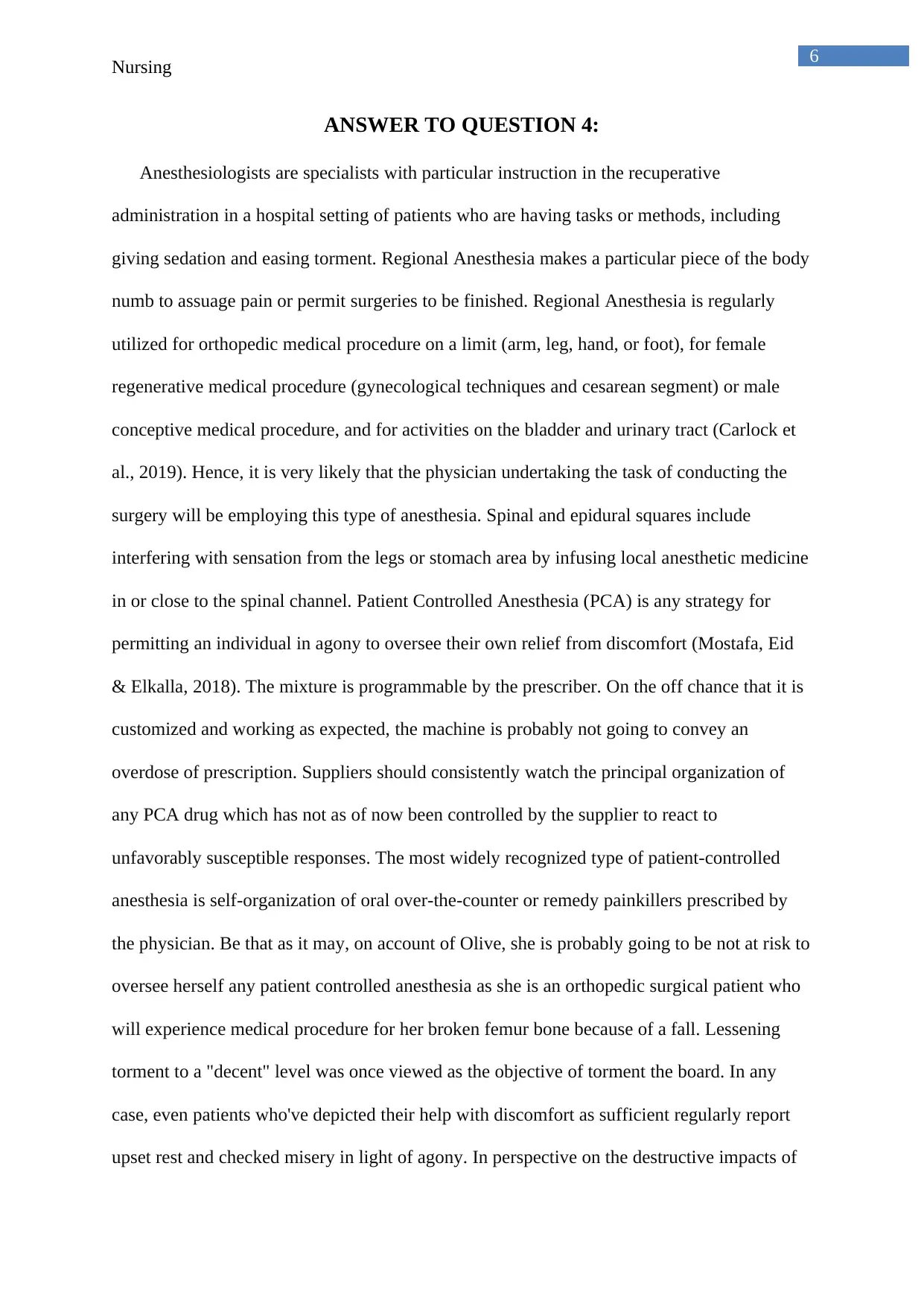
6
Nursing
ANSWER TO QUESTION 4:
Anesthesiologists are specialists with particular instruction in the recuperative
administration in a hospital setting of patients who are having tasks or methods, including
giving sedation and easing torment. Regional Anesthesia makes a particular piece of the body
numb to assuage pain or permit surgeries to be finished. Regional Anesthesia is regularly
utilized for orthopedic medical procedure on a limit (arm, leg, hand, or foot), for female
regenerative medical procedure (gynecological techniques and cesarean segment) or male
conceptive medical procedure, and for activities on the bladder and urinary tract (Carlock et
al., 2019). Hence, it is very likely that the physician undertaking the task of conducting the
surgery will be employing this type of anesthesia. Spinal and epidural squares include
interfering with sensation from the legs or stomach area by infusing local anesthetic medicine
in or close to the spinal channel. Patient Controlled Anesthesia (PCA) is any strategy for
permitting an individual in agony to oversee their own relief from discomfort (Mostafa, Eid
& Elkalla, 2018). The mixture is programmable by the prescriber. On the off chance that it is
customized and working as expected, the machine is probably not going to convey an
overdose of prescription. Suppliers should consistently watch the principal organization of
any PCA drug which has not as of now been controlled by the supplier to react to
unfavorably susceptible responses. The most widely recognized type of patient-controlled
anesthesia is self-organization of oral over-the-counter or remedy painkillers prescribed by
the physician. Be that as it may, on account of Olive, she is probably going to be not at risk to
oversee herself any patient controlled anesthesia as she is an orthopedic surgical patient who
will experience medical procedure for her broken femur bone because of a fall. Lessening
torment to a "decent" level was once viewed as the objective of torment the board. In any
case, even patients who've depicted their help with discomfort as sufficient regularly report
upset rest and checked misery in light of agony. In perspective on the destructive impacts of
Nursing
ANSWER TO QUESTION 4:
Anesthesiologists are specialists with particular instruction in the recuperative
administration in a hospital setting of patients who are having tasks or methods, including
giving sedation and easing torment. Regional Anesthesia makes a particular piece of the body
numb to assuage pain or permit surgeries to be finished. Regional Anesthesia is regularly
utilized for orthopedic medical procedure on a limit (arm, leg, hand, or foot), for female
regenerative medical procedure (gynecological techniques and cesarean segment) or male
conceptive medical procedure, and for activities on the bladder and urinary tract (Carlock et
al., 2019). Hence, it is very likely that the physician undertaking the task of conducting the
surgery will be employing this type of anesthesia. Spinal and epidural squares include
interfering with sensation from the legs or stomach area by infusing local anesthetic medicine
in or close to the spinal channel. Patient Controlled Anesthesia (PCA) is any strategy for
permitting an individual in agony to oversee their own relief from discomfort (Mostafa, Eid
& Elkalla, 2018). The mixture is programmable by the prescriber. On the off chance that it is
customized and working as expected, the machine is probably not going to convey an
overdose of prescription. Suppliers should consistently watch the principal organization of
any PCA drug which has not as of now been controlled by the supplier to react to
unfavorably susceptible responses. The most widely recognized type of patient-controlled
anesthesia is self-organization of oral over-the-counter or remedy painkillers prescribed by
the physician. Be that as it may, on account of Olive, she is probably going to be not at risk to
oversee herself any patient controlled anesthesia as she is an orthopedic surgical patient who
will experience medical procedure for her broken femur bone because of a fall. Lessening
torment to a "decent" level was once viewed as the objective of torment the board. In any
case, even patients who've depicted their help with discomfort as sufficient regularly report
upset rest and checked misery in light of agony. In perspective on the destructive impacts of
Paraphrase This Document
Need a fresh take? Get an instant paraphrase of this document with our AI Paraphraser
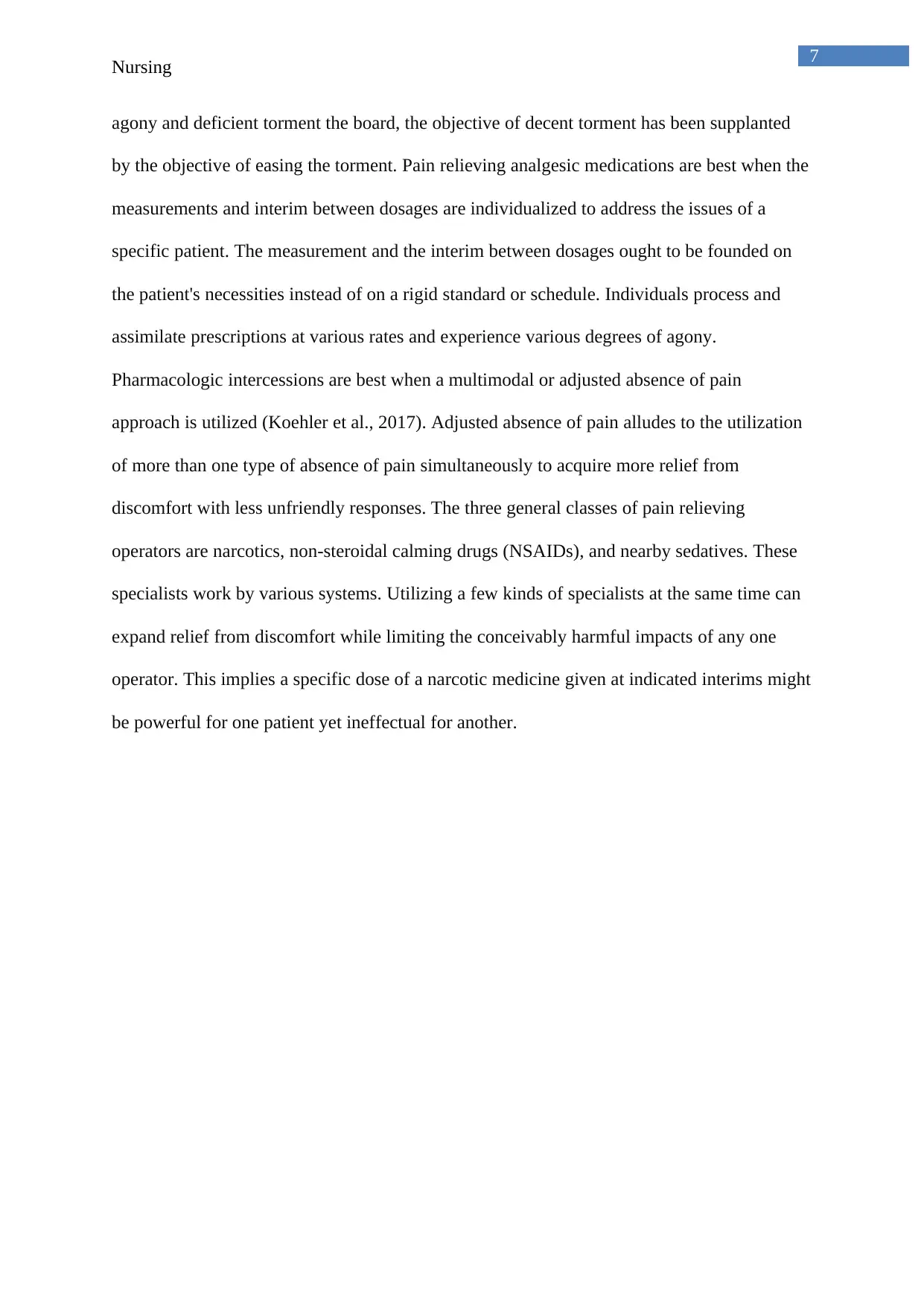
7
Nursing
agony and deficient torment the board, the objective of decent torment has been supplanted
by the objective of easing the torment. Pain relieving analgesic medications are best when the
measurements and interim between dosages are individualized to address the issues of a
specific patient. The measurement and the interim between dosages ought to be founded on
the patient's necessities instead of on a rigid standard or schedule. Individuals process and
assimilate prescriptions at various rates and experience various degrees of agony.
Pharmacologic intercessions are best when a multimodal or adjusted absence of pain
approach is utilized (Koehler et al., 2017). Adjusted absence of pain alludes to the utilization
of more than one type of absence of pain simultaneously to acquire more relief from
discomfort with less unfriendly responses. The three general classes of pain relieving
operators are narcotics, non-steroidal calming drugs (NSAIDs), and nearby sedatives. These
specialists work by various systems. Utilizing a few kinds of specialists at the same time can
expand relief from discomfort while limiting the conceivably harmful impacts of any one
operator. This implies a specific dose of a narcotic medicine given at indicated interims might
be powerful for one patient yet ineffectual for another.
Nursing
agony and deficient torment the board, the objective of decent torment has been supplanted
by the objective of easing the torment. Pain relieving analgesic medications are best when the
measurements and interim between dosages are individualized to address the issues of a
specific patient. The measurement and the interim between dosages ought to be founded on
the patient's necessities instead of on a rigid standard or schedule. Individuals process and
assimilate prescriptions at various rates and experience various degrees of agony.
Pharmacologic intercessions are best when a multimodal or adjusted absence of pain
approach is utilized (Koehler et al., 2017). Adjusted absence of pain alludes to the utilization
of more than one type of absence of pain simultaneously to acquire more relief from
discomfort with less unfriendly responses. The three general classes of pain relieving
operators are narcotics, non-steroidal calming drugs (NSAIDs), and nearby sedatives. These
specialists work by various systems. Utilizing a few kinds of specialists at the same time can
expand relief from discomfort while limiting the conceivably harmful impacts of any one
operator. This implies a specific dose of a narcotic medicine given at indicated interims might
be powerful for one patient yet ineffectual for another.
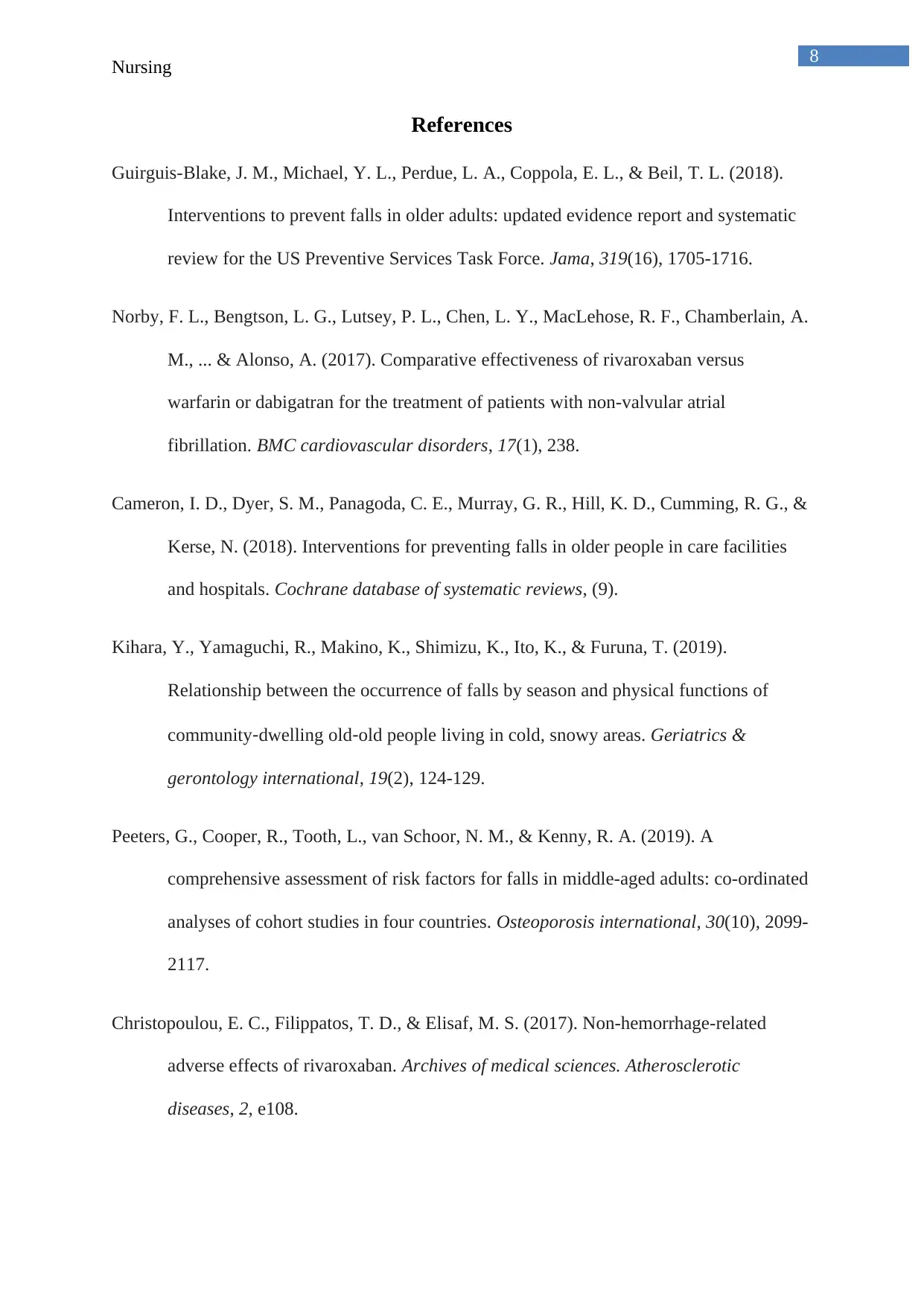
8
Nursing
References
Guirguis-Blake, J. M., Michael, Y. L., Perdue, L. A., Coppola, E. L., & Beil, T. L. (2018).
Interventions to prevent falls in older adults: updated evidence report and systematic
review for the US Preventive Services Task Force. Jama, 319(16), 1705-1716.
Norby, F. L., Bengtson, L. G., Lutsey, P. L., Chen, L. Y., MacLehose, R. F., Chamberlain, A.
M., ... & Alonso, A. (2017). Comparative effectiveness of rivaroxaban versus
warfarin or dabigatran for the treatment of patients with non-valvular atrial
fibrillation. BMC cardiovascular disorders, 17(1), 238.
Cameron, I. D., Dyer, S. M., Panagoda, C. E., Murray, G. R., Hill, K. D., Cumming, R. G., &
Kerse, N. (2018). Interventions for preventing falls in older people in care facilities
and hospitals. Cochrane database of systematic reviews, (9).
Kihara, Y., Yamaguchi, R., Makino, K., Shimizu, K., Ito, K., & Furuna, T. (2019).
Relationship between the occurrence of falls by season and physical functions of
community‐dwelling old‐old people living in cold, snowy areas. Geriatrics &
gerontology international, 19(2), 124-129.
Peeters, G., Cooper, R., Tooth, L., van Schoor, N. M., & Kenny, R. A. (2019). A
comprehensive assessment of risk factors for falls in middle-aged adults: co-ordinated
analyses of cohort studies in four countries. Osteoporosis international, 30(10), 2099-
2117.
Christopoulou, E. C., Filippatos, T. D., & Elisaf, M. S. (2017). Non-hemorrhage-related
adverse effects of rivaroxaban. Archives of medical sciences. Atherosclerotic
diseases, 2, e108.
Nursing
References
Guirguis-Blake, J. M., Michael, Y. L., Perdue, L. A., Coppola, E. L., & Beil, T. L. (2018).
Interventions to prevent falls in older adults: updated evidence report and systematic
review for the US Preventive Services Task Force. Jama, 319(16), 1705-1716.
Norby, F. L., Bengtson, L. G., Lutsey, P. L., Chen, L. Y., MacLehose, R. F., Chamberlain, A.
M., ... & Alonso, A. (2017). Comparative effectiveness of rivaroxaban versus
warfarin or dabigatran for the treatment of patients with non-valvular atrial
fibrillation. BMC cardiovascular disorders, 17(1), 238.
Cameron, I. D., Dyer, S. M., Panagoda, C. E., Murray, G. R., Hill, K. D., Cumming, R. G., &
Kerse, N. (2018). Interventions for preventing falls in older people in care facilities
and hospitals. Cochrane database of systematic reviews, (9).
Kihara, Y., Yamaguchi, R., Makino, K., Shimizu, K., Ito, K., & Furuna, T. (2019).
Relationship between the occurrence of falls by season and physical functions of
community‐dwelling old‐old people living in cold, snowy areas. Geriatrics &
gerontology international, 19(2), 124-129.
Peeters, G., Cooper, R., Tooth, L., van Schoor, N. M., & Kenny, R. A. (2019). A
comprehensive assessment of risk factors for falls in middle-aged adults: co-ordinated
analyses of cohort studies in four countries. Osteoporosis international, 30(10), 2099-
2117.
Christopoulou, E. C., Filippatos, T. D., & Elisaf, M. S. (2017). Non-hemorrhage-related
adverse effects of rivaroxaban. Archives of medical sciences. Atherosclerotic
diseases, 2, e108.
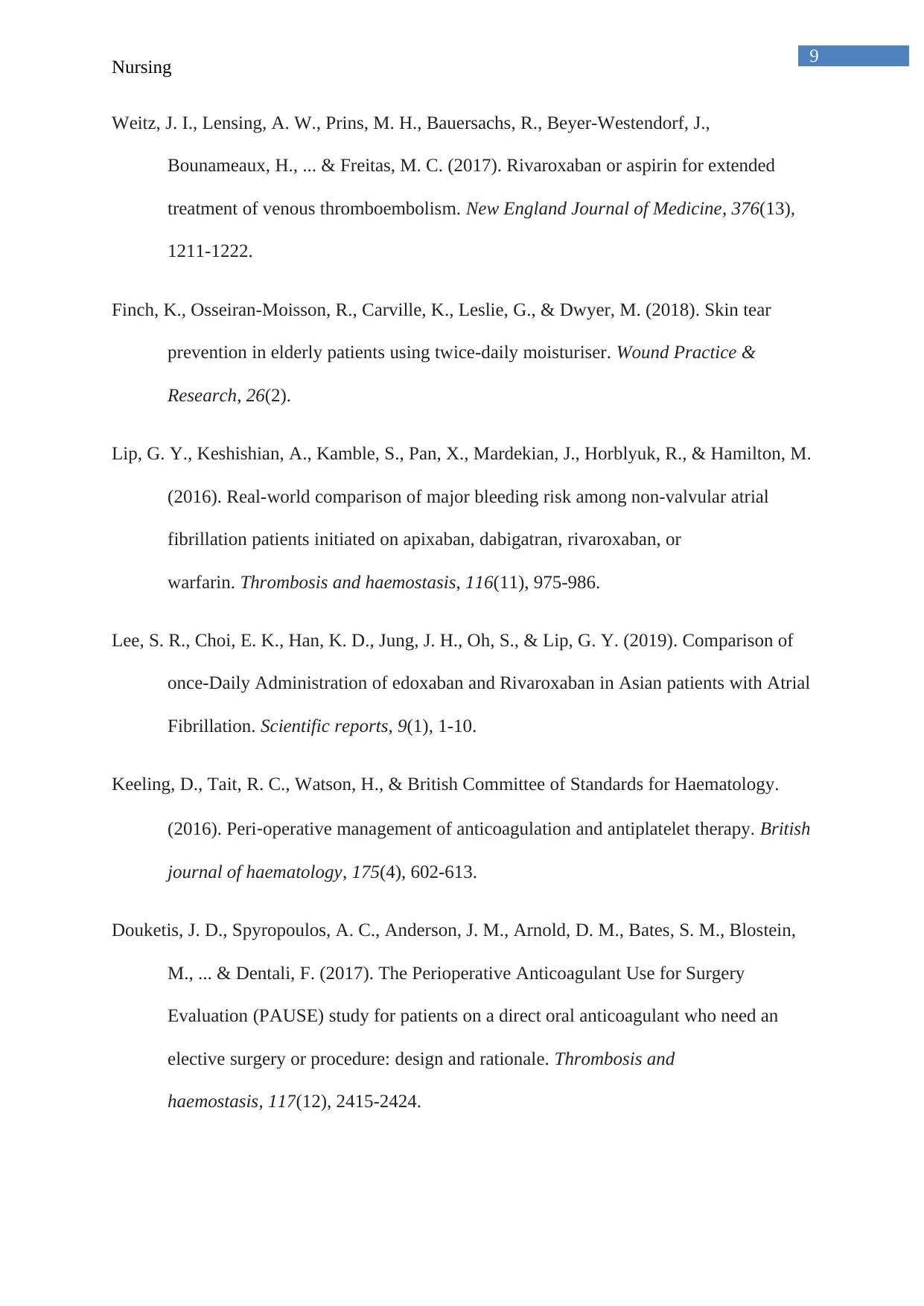
9
Nursing
Weitz, J. I., Lensing, A. W., Prins, M. H., Bauersachs, R., Beyer-Westendorf, J.,
Bounameaux, H., ... & Freitas, M. C. (2017). Rivaroxaban or aspirin for extended
treatment of venous thromboembolism. New England Journal of Medicine, 376(13),
1211-1222.
Finch, K., Osseiran-Moisson, R., Carville, K., Leslie, G., & Dwyer, M. (2018). Skin tear
prevention in elderly patients using twice-daily moisturiser. Wound Practice &
Research, 26(2).
Lip, G. Y., Keshishian, A., Kamble, S., Pan, X., Mardekian, J., Horblyuk, R., & Hamilton, M.
(2016). Real-world comparison of major bleeding risk among non-valvular atrial
fibrillation patients initiated on apixaban, dabigatran, rivaroxaban, or
warfarin. Thrombosis and haemostasis, 116(11), 975-986.
Lee, S. R., Choi, E. K., Han, K. D., Jung, J. H., Oh, S., & Lip, G. Y. (2019). Comparison of
once-Daily Administration of edoxaban and Rivaroxaban in Asian patients with Atrial
Fibrillation. Scientific reports, 9(1), 1-10.
Keeling, D., Tait, R. C., Watson, H., & British Committee of Standards for Haematology.
(2016). Peri‐operative management of anticoagulation and antiplatelet therapy. British
journal of haematology, 175(4), 602-613.
Douketis, J. D., Spyropoulos, A. C., Anderson, J. M., Arnold, D. M., Bates, S. M., Blostein,
M., ... & Dentali, F. (2017). The Perioperative Anticoagulant Use for Surgery
Evaluation (PAUSE) study for patients on a direct oral anticoagulant who need an
elective surgery or procedure: design and rationale. Thrombosis and
haemostasis, 117(12), 2415-2424.
Nursing
Weitz, J. I., Lensing, A. W., Prins, M. H., Bauersachs, R., Beyer-Westendorf, J.,
Bounameaux, H., ... & Freitas, M. C. (2017). Rivaroxaban or aspirin for extended
treatment of venous thromboembolism. New England Journal of Medicine, 376(13),
1211-1222.
Finch, K., Osseiran-Moisson, R., Carville, K., Leslie, G., & Dwyer, M. (2018). Skin tear
prevention in elderly patients using twice-daily moisturiser. Wound Practice &
Research, 26(2).
Lip, G. Y., Keshishian, A., Kamble, S., Pan, X., Mardekian, J., Horblyuk, R., & Hamilton, M.
(2016). Real-world comparison of major bleeding risk among non-valvular atrial
fibrillation patients initiated on apixaban, dabigatran, rivaroxaban, or
warfarin. Thrombosis and haemostasis, 116(11), 975-986.
Lee, S. R., Choi, E. K., Han, K. D., Jung, J. H., Oh, S., & Lip, G. Y. (2019). Comparison of
once-Daily Administration of edoxaban and Rivaroxaban in Asian patients with Atrial
Fibrillation. Scientific reports, 9(1), 1-10.
Keeling, D., Tait, R. C., Watson, H., & British Committee of Standards for Haematology.
(2016). Peri‐operative management of anticoagulation and antiplatelet therapy. British
journal of haematology, 175(4), 602-613.
Douketis, J. D., Spyropoulos, A. C., Anderson, J. M., Arnold, D. M., Bates, S. M., Blostein,
M., ... & Dentali, F. (2017). The Perioperative Anticoagulant Use for Surgery
Evaluation (PAUSE) study for patients on a direct oral anticoagulant who need an
elective surgery or procedure: design and rationale. Thrombosis and
haemostasis, 117(12), 2415-2424.
Secure Best Marks with AI Grader
Need help grading? Try our AI Grader for instant feedback on your assignments.
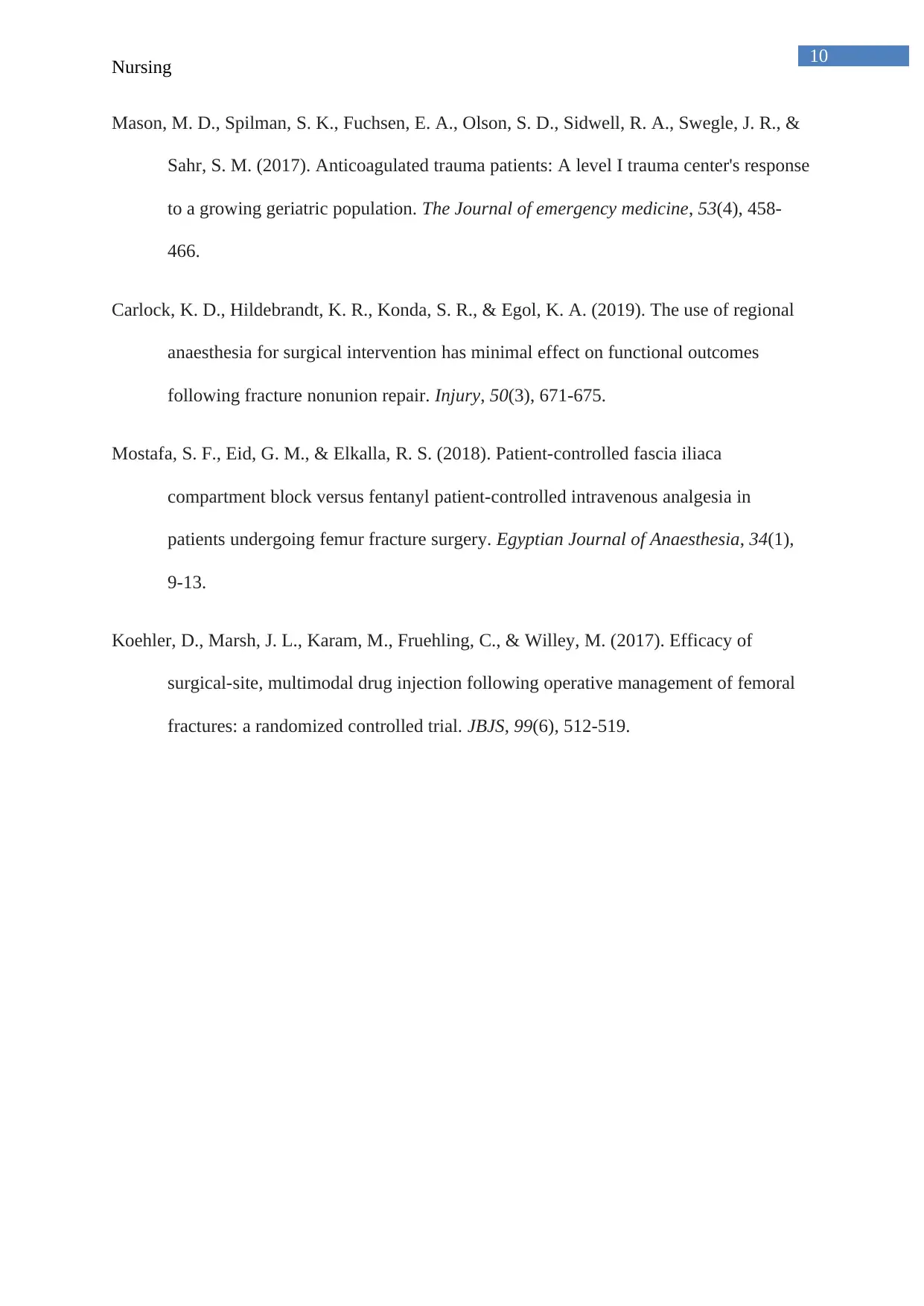
10
Nursing
Mason, M. D., Spilman, S. K., Fuchsen, E. A., Olson, S. D., Sidwell, R. A., Swegle, J. R., &
Sahr, S. M. (2017). Anticoagulated trauma patients: A level I trauma center's response
to a growing geriatric population. The Journal of emergency medicine, 53(4), 458-
466.
Carlock, K. D., Hildebrandt, K. R., Konda, S. R., & Egol, K. A. (2019). The use of regional
anaesthesia for surgical intervention has minimal effect on functional outcomes
following fracture nonunion repair. Injury, 50(3), 671-675.
Mostafa, S. F., Eid, G. M., & Elkalla, R. S. (2018). Patient-controlled fascia iliaca
compartment block versus fentanyl patient-controlled intravenous analgesia in
patients undergoing femur fracture surgery. Egyptian Journal of Anaesthesia, 34(1),
9-13.
Koehler, D., Marsh, J. L., Karam, M., Fruehling, C., & Willey, M. (2017). Efficacy of
surgical-site, multimodal drug injection following operative management of femoral
fractures: a randomized controlled trial. JBJS, 99(6), 512-519.
Nursing
Mason, M. D., Spilman, S. K., Fuchsen, E. A., Olson, S. D., Sidwell, R. A., Swegle, J. R., &
Sahr, S. M. (2017). Anticoagulated trauma patients: A level I trauma center's response
to a growing geriatric population. The Journal of emergency medicine, 53(4), 458-
466.
Carlock, K. D., Hildebrandt, K. R., Konda, S. R., & Egol, K. A. (2019). The use of regional
anaesthesia for surgical intervention has minimal effect on functional outcomes
following fracture nonunion repair. Injury, 50(3), 671-675.
Mostafa, S. F., Eid, G. M., & Elkalla, R. S. (2018). Patient-controlled fascia iliaca
compartment block versus fentanyl patient-controlled intravenous analgesia in
patients undergoing femur fracture surgery. Egyptian Journal of Anaesthesia, 34(1),
9-13.
Koehler, D., Marsh, J. L., Karam, M., Fruehling, C., & Willey, M. (2017). Efficacy of
surgical-site, multimodal drug injection following operative management of femoral
fractures: a randomized controlled trial. JBJS, 99(6), 512-519.
1 out of 11
Related Documents
Your All-in-One AI-Powered Toolkit for Academic Success.
+13062052269
info@desklib.com
Available 24*7 on WhatsApp / Email
![[object Object]](/_next/static/media/star-bottom.7253800d.svg)
Unlock your academic potential
© 2024 | Zucol Services PVT LTD | All rights reserved.





